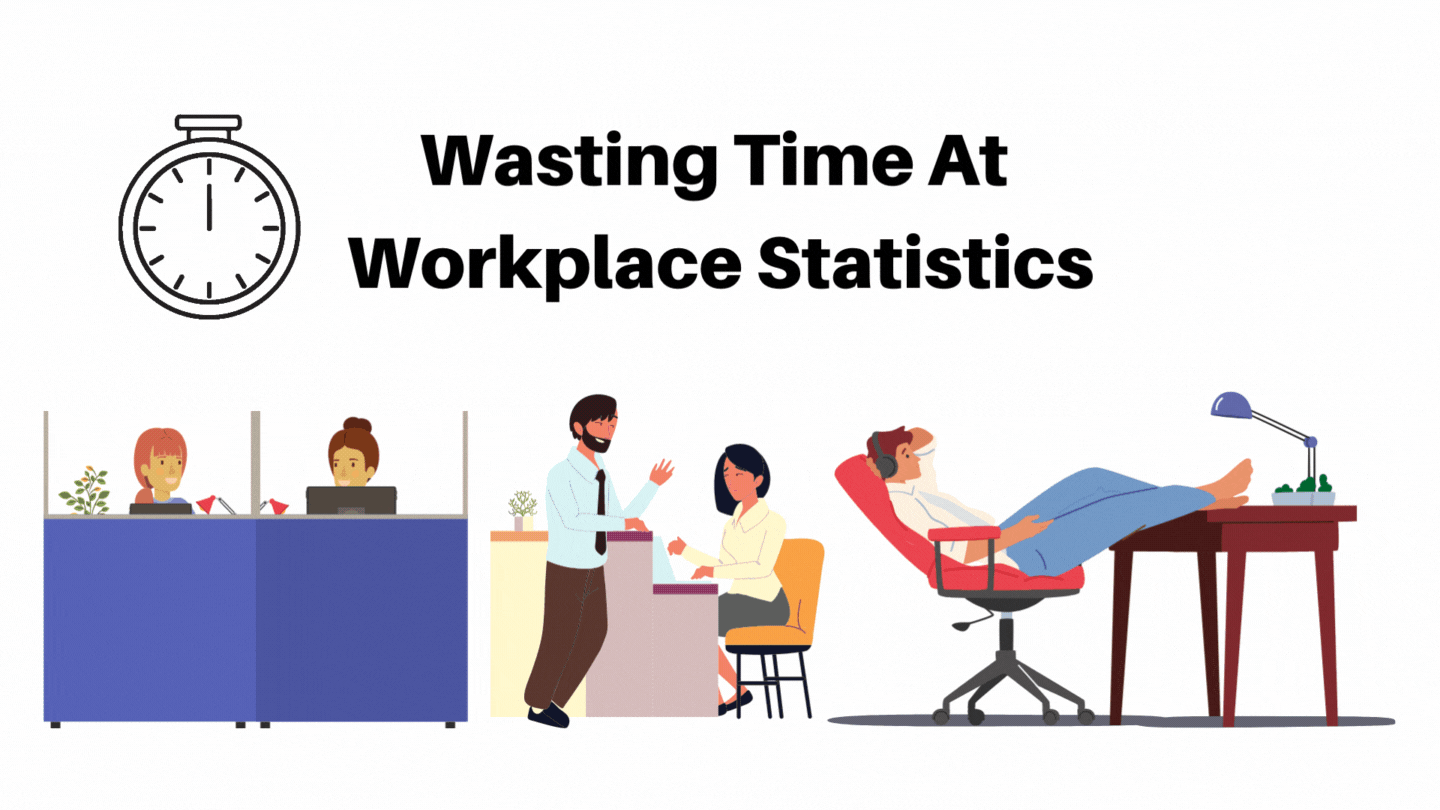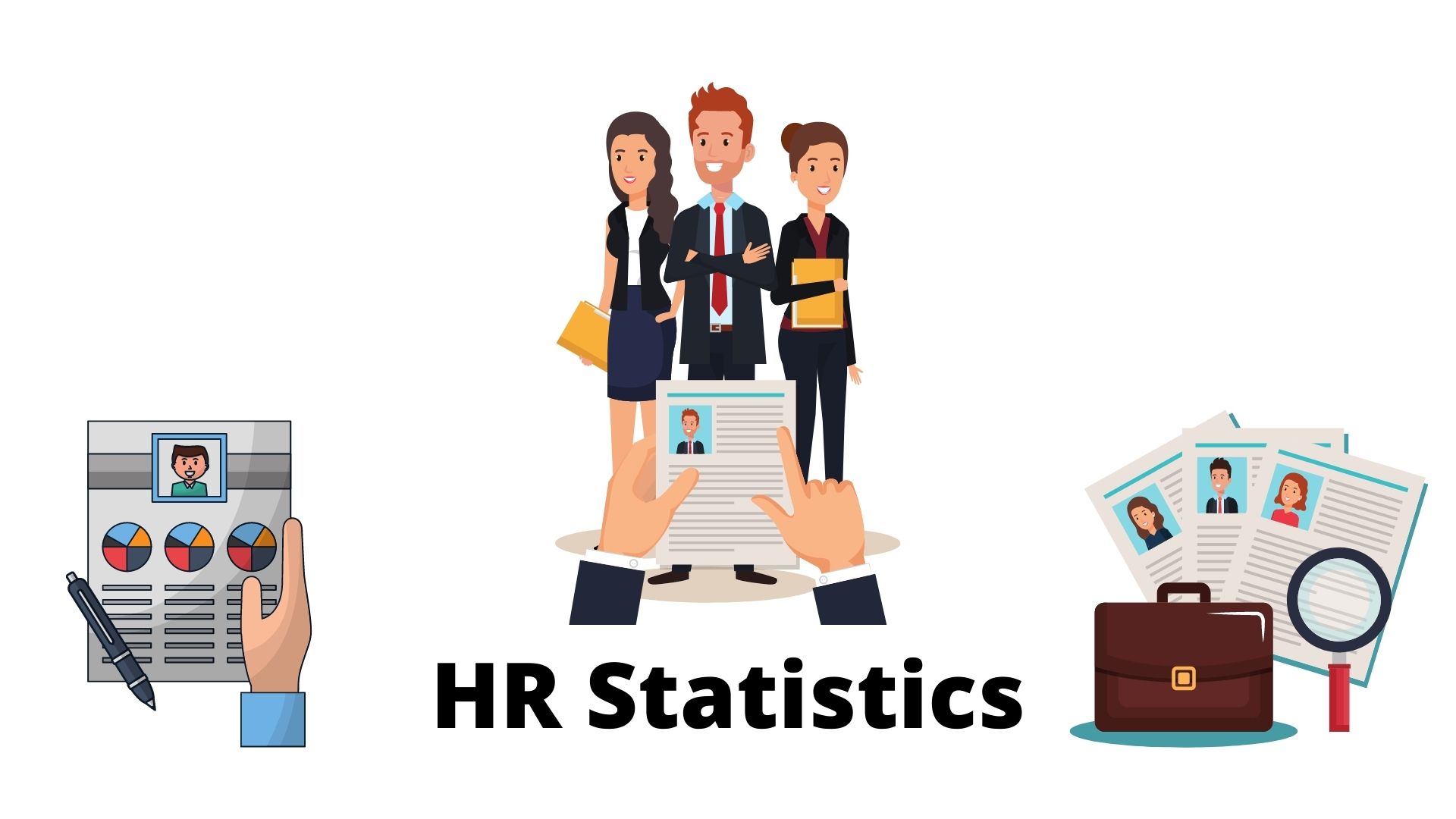20+ Wasting Time At Workplace Statistics – The Surprising Truth About Office Productivity

Page Contents
- Wasting Time At Workplace Statistics (Editor's Choice)
- How We Waste Time In The Workplace
- By Employee Reports
- By Employee At Meetings In The Workplace
- By Wasteful Work-Related Activities
- By The Biggest Distractions
- Reasons for wasting time
- Exactly Why Do We Waste Our Time In The Workplace?
- How To Stop Wasting Time At Work?
- Conclusion
Wasting Time At Workplace Statistics: In our fast-paced, high-pressure world, getting caught up in the idea that we should be productive every waking moment is easy. However new research suggests that taking some time for leisure activities at work can actually make us more effective overall.
So how can we justify wasting time at the workplace? For one thing, it can help us relieve stress and recharge our batteries.
We all waste our time at the workplace daily, from entry-level workers to those in leadership positions. If you're wasting time at work, it is vital to know how much time you spend. Time management is an important skill that needs to be developed; the more rarely you practice it, the less likely you are to keep track of your time.
We've all experienced it. You are sitting at your desk, mindlessly scrolling through social media or chatting with coworkers when you should be working. For some, it is a way to take a break from the monotony of the workday. There are several reasons why we waste time at work.
This article will discuss the surprising waste of time on workplace statistics and facts. We also will discuss how to stop wasting time at work.
Wasting Time At Workplace Statistics (Editor's Choice)
- As of 2023, almost 89% of workers stated that they are wasting time every day at work.
- In the United States, during 8 hours of working time, employees waste an average of 2.9 hours by doing no effective work.
- On a regular basis, around 64% of employees visit many websites that are not linked with work-related topics.
- 31% of workers waste a minimum of 1 hour each workday.
- Nearly 89% of respondents state that they spend an average of 30 minutes at work daily.
- 6% of employees waste around 3 hours each day at work.
- 53% of employees claim that they take short breaks from work to do activities not related to work in order to boost productivity.
- 4% of workers claim they waste at least 4 hours daily in the workplace.
- In 2023, employees spend approximately 21.5 hours per week meeting, and on average employees attend 62 monthly meetings.
- The main cause of wasting time at the workplace is meetings claimed by 47% of employees.
- Employees mostly check out their emails more than 121 times during working hours.
- Companies in the United States waste approximately $37 billion annually on unnecessary meetings.
- For every 100 employees, companies in the United States lose, on average, $1.7 million annually due to wasted time.
- Employees waste over 21 days per year performing repetitive or menial activities at the workplace.
- The average worker checks email 36 times in 1 hour.
How We Waste Time In The Workplace
Thanks to the wondrous world of technology and the internet, we can now take our job everywhere. But it also means we bring our most significant time-wasting habits. Time management statistics are a goldmine for organizations wanting to increase productivity and identify problem areas. So what are some of the factors that are impeding our workflow?
A. Using Social Media In The Workplace
Many people worldwide tend to reach for their phones and check their notifications. This has become a routine. Statistics on time wastage at work show that social media is one of the most common culprits. We spend around 1 hour and a half of our workday scrolling through social networking applications, which adds up to 7.5 hours each week. This puts them in the top ten time wasters at work.
B. The Internet
The internet, which has revolutionized companies is also a significant time-waster in the workplace. Even though many businesses have tight regulations in place and prohibit particular websites, many internet time-wasters still manage to spend 21 hours each week online. That equates to 48% of each working day spent online, whether surfing sites, checking social media platforms, or online shopping.
C. Professional vs. Personal Communication
Communication plays a vital role in employees' work lives. Approximately 56 minutes per day are spent making personal calls, texting, or reading messages. This has become an accepted way of working life for professionals in the 21st century. It does not mean that we can't take steps to reduce the number of pointless personal conversations. This also applies to the discussions we have with our colleagues. In order to avoid wasting organizational time, it is crucial to limit small talk to a minimum whenever feasible.
D. Our Email Culture
We depend on email to communicate at our workplace. This means we constantly check for fresh information. Wasting time at workplace statistics show that we do this 121 times every day in the year 2023. It is one of the most common office time wasters accounting for 28% of the workweek. In addition, making emails more effective and streamlining business communications are two essential methods to reduce the amount of time employees waste at work.
E. Ineffective Training Practices
While it is important to welcome new employees into the company and familiarize them with their new roles, many companies fail to realize this. Statistics on workplace distractions reveal that many new employees feel lost and confused after training. They don't know how to apply this information to their current position.
Furthermore, one-fourth of all workers believe their training was a waste of time and has no benefit. The time wasted on pointless training costs organizations millions of dollars annually and thousands on every worker individually.
F. Lack Of Motivation And Distraction
Wasting time at the workplace statistics show that lack of motivation and being distracted are the top two time wasters in many organizations worldwide. Of course, everyone wants to be productive when it is necessary, but maintaining or regaining focus can be difficult. According to a survey about wasting time at the workplace, the average employee is distracted every 11 minutes, and it might take up to 25 minutes to get back on task.
G. Low-Value Work And Menial Jobs
Most of us have spent several years and thousands of dollars learning complex skills for our professions. It is so strange that our day is filled with several mundane tasks. Numerous tasks that take up crucial working time but are easily automated include filling in timesheets and calculating daily reports. Each week, a full working day is lost on these basic and ineffective activities. That equates to 50 days on average each year.
We divided the information into the following categories for further analysis:
- Employee Reports
- Meetings
- Work-Related Task
- Distractions
By Employee Reports
#1. Around16% of employees state that they waste approximately 2 hours a day at work.
#2. 20% of employees claim they squander time because they are uninterested in their work or are bored with it.
#3. 31% of workers waste a minimum of 31 minutes each workday.
#4. Furthermore, 31% of employees waste 1 hour each day.
#5. The amount of time that is actually productive at work is less than 60%.
#6. 6% of employees waste around 3 hours each day at work.
#7. Furthermore, other 2% of employees waste 4 hours and another 2% waste more than 5 hours on a regular working day.
#8. 53% of employees claim that they take short breaks from work to do activities not related to work in order to boost productivity.
#9. According to workers, approximately interruptions they experience in the workplace are minor.
#10. 4% of workers claim they waste at least 4 hours daily in the workplace.
| Distracting Activity | Percentage of Employees Who Participate |
| Surf the internet | 47% |
| Social media | 45% |
| Texting | 44% |
| Bathroom breaks | 39% |
| Socializing with coworkers | 27% |
| Snack breaks | 25% |
| Other coworkers’/office noise | 25% |
| Coffee breaks | 19% |
| Reading/drawing | 16% |
| Household activities | 14% |
By Employee At Meetings In The Workplace
Unfortunately, one of the most notable time wasages involves something meant to benefit the employer and its employees.
- According to time spent meetings stats, approximately 11 million meetings occur annually.
- In these meetings, 95% of workers admit to completely missing the meetings.
- As of 2023, 91% of employees during meetings reported daydreaming.
- According to workplace statistics, nearly 39% of employees reported falling asleep.
- While 73% of employees state they even bring irrelevant tasks.
#10. The average worker spends around 21.5 hours each week in meetings.
This is for an average worker: Extremely busy One attends meetings for about 33 hours weekly. This is a significant portion of a 40-hour workweek, even though busy professionals generally work closer to 45-50 hours per week.
#11. According to 47% of workers, meetings were the most time-consuming part of work.
Around 73% of workers try to make up for their time in meetings by working on other tasks.
However, 45% of workers still find the number of meetings they must attend burdensome.
#12. An average worker attends roughly 62 meetings per month.
These meetings usually last about an hour if you add that with the fact that approximately half of the meetings are deemed ineffective, that equates to around 31 hours every month spent in non-productive meetings.
#13. Companies in the United States waste approximately $37 billion annually on unnecessary meetings.
This money originates from salaries employers pay staff members to attend pointless meetings. It doesn't even include the money wasted on food and facilities at these unneeded get-togethers.
By Wasteful Work-Related Activities
#14. For every 100 employees, companies in the United States lose, on average, $1.7 million annually due to wasted time.
That implies that a company with around 300 staff members loses approximately $5.1 million annually due to their employees' time-wasting. This could be time squandered on socializing or personal matters, but the organization could also waste it because of excessive meeting demands or inefficient email communication.
#15. The average employee checks their work email for almost three and a half hours every day.
This does not include the time they spend reading their personal email, which can consume up to 2 hours & 23 minutes of their workday. That equates to over 6 hours of email checking daily.
#16. Employees waste over 21 days per year performing repetitive or menial activities at the workplace.
These activities could be done automatically, saving businesses hundreds and thousands of dollars.
By The Biggest Distractions
#17. The average worker checks email 36 times in 1 hour.
Even though emails alone take up a significant amount of time, it also takes approximately 16 minutes for someone to regain attention after reading or replying to an email, which reduces the available time for productive work even further.
Furthermore, managing a steady stream of emails reduces workers' productivity even when they are free from distractions. Studies show that workers lose roughly 10 IQ points from dealing with this persistent email stream throughout the day. Doing so is equivalent to missing a whole night of sleep.
#18. Each week, the average worker receives around 304 emails for work.
Numerous of them are unnecessary, spam, or just poorly written, costing organizations time and money as staff members have to sort through them all and try to understand what is being said.
Spam emails cost businesses approximately $1250 per staff member in productivity losses. Unnecessary emails can cost $1800 per worker, while poorly written communications can cost between $2100 and $4100 per employee.
#19. An employee gets interrupted 121 times due to emails every day on the job.
The time lost due to interruptions is also not limited to the disruptions themselves; the average worker spends two hours every day trying to regain focus after being interrupted.
#20. Checking social media and internet browsing are two of the most distracting activities for employees.
These are the top 10 distractions employees face during working hours and the percentage of workers who admit they are distracted by them.
| Distracting Activity | Percentage of Staff Members Who Participate |
|---|---|
| Social media | 45% |
| Bathroom breaks | 39% |
| Surf the Internet | 47% |
| Texting | 44% |
| Snack breaks | 25% |
| Coffee breaks | 19% |
| Socializing with colleagues | 27% |
| Other colleagues/office noise | 25% |
| Household activities | 14% |
| Drawing/reading | 16% |
Reasons for wasting time
As of 2023, around 53% of employees that breaks within working hours can aid more productivity.
Other reasons why people waste more time during their working hours are followed by boredom (20%), lack of incentive (8%), dissatisfaction with their jobs (7%), and employees not being paid enough (2%).
Exactly Why Do We Waste Our Time In The Workplace?
The psychology of time-wasting in the workplace is more complex and easy to understand. Wasting time in the workplace statistics reveals that it is an entirely normal response to productivity. Whether the push element comes from the individual or the company, the end result is the same: less attention, less productivity, and more money wasted. A few of the reasons are listed below.
It Depends On Which Day Of The Week:
Even something abstract, such as a specific day of the week, can keep us from being productive in our workplace. Unsurprisingly, Fridays are the worst days to waste time at work.
In 2023 according to wasting time at the workplace statistics, 40% of staff members confess that they waste most of their time on Fridays.
22% of the workforce admits that they waste their hours between 3 PM and 5 PM.
Monday afternoons are the other day of the week when staff members waste the majority of their time, with 18% of employees stating that their productivity drastically declines after 1 p.m.
Ineffective “Break Culture” In The Organization:
According to statistics on wasting time in the workplace, taking breaks does not cause a decline in productivity. But instead, how and when we take breaks that are so important. Productivity statistics indicate that it is physically impossible for a person to work continuously for 8 to 10 hours. The top 10% of productive employees work for approximately 52 minutes and then take a 17-minute break. When you calculate these minutes, it can appear that they are wasting a significant portion of their workday taking breaks. However, these workers make excellent use of their 52 minutes, making the rest irrelevant.
We Mistake Wasting Time To Be Productive
As weird as it may sound, we believe that short-term inactivity will ultimately result in greater productivity. 53% of employees think taking regular breaks means improving their work quality. We have to go down to 20% for the next most significant contributor: lack of interest and boredom in employment. Being underpaid is at about 2%, and work dissatisfaction is at 7%.
How To Stop Wasting Time At Work?
We need to increase our productivity and stop employees from wasting time at the workplace. There are two potential sources for these answers. One is for staff members to take activities into their own hands and keep track of their output. The other is for organizations to implement protocols and structures to assist their staff in working more productively by simplifying particular departments.
Decluttering And Clearing Our Communications
We may regain and redirect our attention by reevaluating how we communicate at the workplace. Dialogue is a key factor in improving communication. According to wasting time at workplace statistics, approximately 84% of all staff members leave their emails open throughout the day, and 70% of emails are opened within 6 seconds. We check our emails every 6 minutes to stay up to date on any developments because, in a corporate structure, it is expected that responses will be given immediately.
Conclusion
There are certainly more distractions around us than at any time in history, and the competition for our attention is not going away. It is almost impossible to find a worker who is productive throughout their eight-hour workday. Approximately 89% of employees say they spend at least 30 minutes working every day, and 4% admit that they waste at most four hours regularly. Businesses must continue exploring ways to keep staff motivated if productivity increases across the board.
Those workers are talking about how they waste their time surfing the internet, scrolling through social media, or texting friends and family. However, many employees also waste their time at work by engaging in work-related activities.
For instance, 47% of workers consider meetings to be the most time-consuming part of their workday.
They might not be too far off, though, because the average worker spends around 21.5 hours per week in meetings- half of which is wasted time. Companies in the United States lose $37 billion annually on pointless meetings.
Sources
FAQ.
People waste time at the workplace because they think taking short breaks will boost their productivity or boredom with their tasks.
53% of workers admit that they take a break from work to do activities not related to work. When individuals return to work after these breaks, they can concentrate better, which in turn improves their overall productivity.
But, 20% of staff members claim that they waste time at the workplace because they are disinterested at work or bored. It's difficult to resist the temptation to waste time when someone is not invested in the work that they are supposed to do.
A smaller percentage of workers claim that they are wasting their time at the workplace because they are unhappy with their jobs (7%), due to lack of incentives (8%), and because they believe that they do not get enough salary (2%).
The actual amount of time spent working at a workplace is less than 60%. However, depending on the person, a large portion of this other 40% of the time is frequently still used for activities related to the job that do not contribute to their productivity.
For instance, the average employee spends roughly three and a half hours per day reading business emails, many of which are either spam or are written so poorly that they require more effort to understand than they should.
Approximately 21.5 hours per week are spent in meetings, the majority of which are pointless. Additionally, workplace distractions significantly decrease productivity because the average worker is interrupted 56 times per day at work.
However, this doesn't mean that all work time is lost due to distractions at work. Around 47% of staff members report surfing the internet while at work, 45% claim that they use social media, and nearly 44% admit to texting from their phones at work.
You can prevent people from wasting time in the workplace by establishing precise goals and deadlines, rewarding productivity, and setting up distraction-free workspaces.
Many managers might initially believe that monitoring workers' internet usage or time use is the most excellent way to prevent them from wasting time. But that is not always the right approach. Staff members who believe they are being micromanaged will not perform any better, and the underlying issue causing them to waste time won't be resolved either.
Instead, emphasize productivity rewards at first. You don't need to reward productivity with a lot of money, but it can significantly reduce wasted time.
Setting precise objectives and deadlines might also be helpful. Staff members who do not know what to do or don't feel they have enough time to meet their next deadline, which is a month away, will be bored and more likely to waste their time.
Instead, set daily, weekly, or even monthly goals for them to achieve so that they know what has to be done and feel like they have enough time to do it. This can be accomplished using project management software, which frequently allows you to divide larger projects into smaller tasks with distinct due dates.
Finally, by offering areas where your staff can work without interruptions, you may be able to cut down on wasted time. This can entail allowing them to work from home or another location away from the office. Alternatively, it might involve designating a workspace where interruptions from emails, phones, or casual passers-by won't be an issue.
This is a great way to reduce distractions and also cut down on the time it takes for you to recover from them. After being distracted, it can take around 20 minutes to refocus. This is a significant time-sink, given the number of interruptions.
It is simpler for employees to stay in their workflow when they have a quiet space to work rather than having their job interrupted every 30 minutes by someone walking by their desk.
The average employee in the United States waste nearly loses 2.9 hours every day at work. During this period, people frequently engage in non-work activities, including social media checking, texting, and surfing the web.
However, this time also includes tasks that are associated with and essential for working in an office, such as using the restroom and getting a coffee, interacting with coworkers, and managing the distracting activities and noises that come with working near other people.
Other time-wasters are responding to and reading emails (the average worker gets 304 work-related emails per week) and attending meetings are other time wasters (workers spend around 21.5 hours per week in meetings).
Because of the productivity losses caused by these interruptions and time-wasters, American businesses lose an average of $1.7 million annually for every 100 people they employ.
The most time waster activities at the workplace include emails, pointless meetings, and surfing the web or social media.
47% of employees believe that meetings are the most time-consuming part of work. This is not an unreasonable opinion considering the average employee attends 62 meetings per month, and approximately half of these are considered time wasters.
Emails are time-wasting activities that are often overlooked. The average worker receives 304 business emails per week; many of them are useless, spam, or increase confusion rather than reduce it.
These legitimate work-related activities are major time-wasters, but many workers waste work hours surfing the web or checking social media. 47% of staff members admit to using the internet at the workplace is a distraction, while 45% of employees state the same about social media.
Nearly 89% of workers are wasting time at work. These employees claim that they waste a minimum of 30 minutes or more daily doing activities unrelated to their jobs.
31% of employees admit to wasting a minimum of 1 hour daily, while 16% of workers claim to waste roughly two hours of each workday. These are the most frequent amounts of time that employees claim to waste each workday. However, 6% of staff members claim to waste around three or more hours daily, and 4% claim to waste a minimum of 4 hours per day.
However, it is unsurprising that every employee wastes time at work daily. The average worker gets interrupted 56 times every day at work, and each employee spends 2 hours each day trying to get back on track after these interruptions.

Barry is a lover of everything technology. Figuring out how the software works and creating content to shed more light on the value it offers users is his favorite pastime. When not evaluating apps or programs, he's busy trying out new healthy recipes, doing yoga, meditating, or taking nature walks with his little one.



